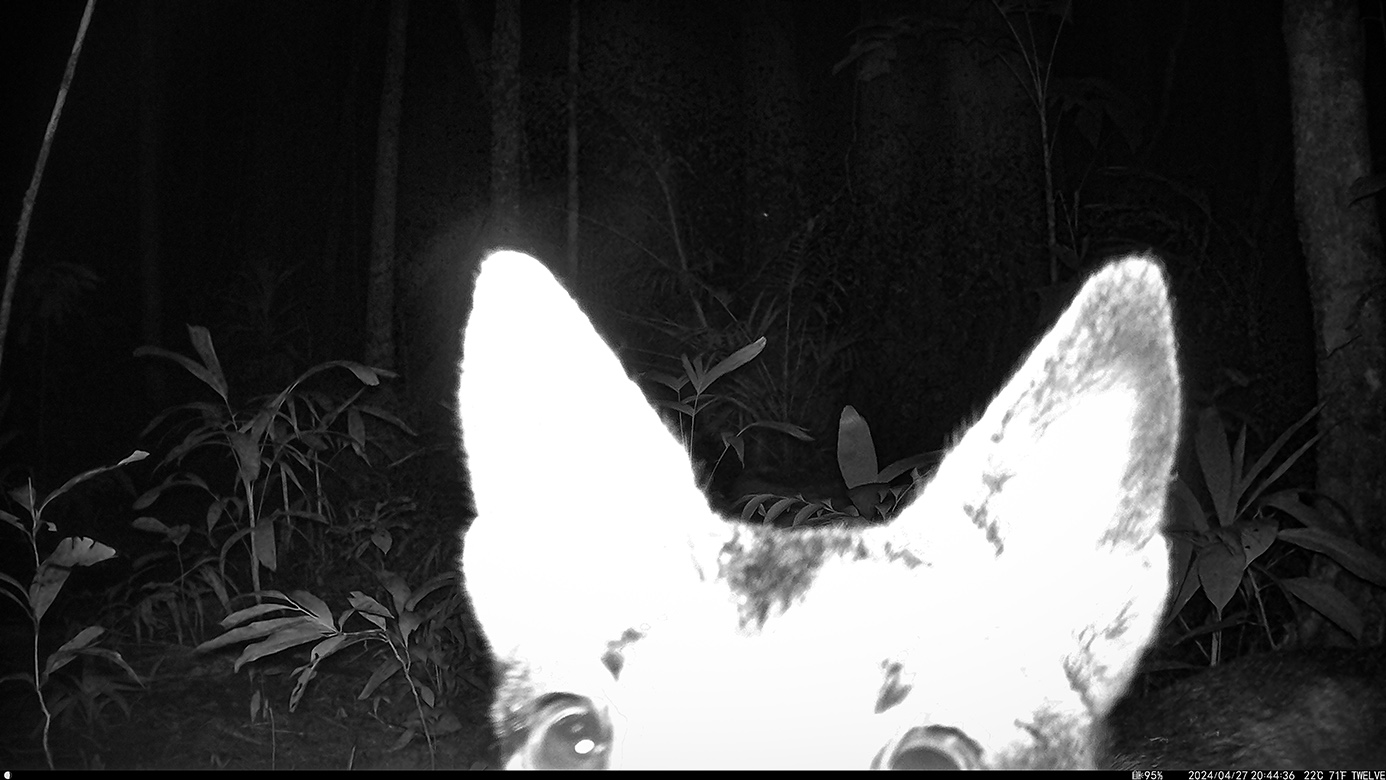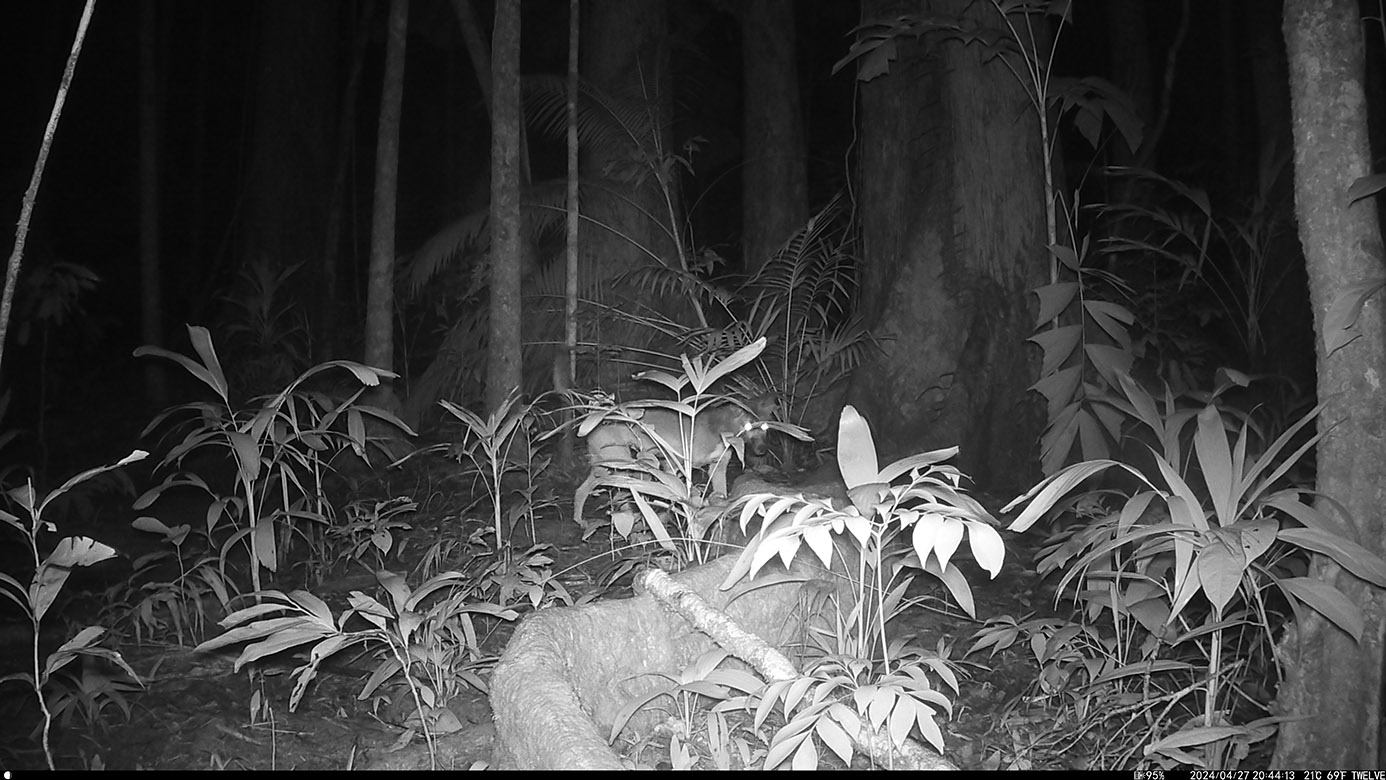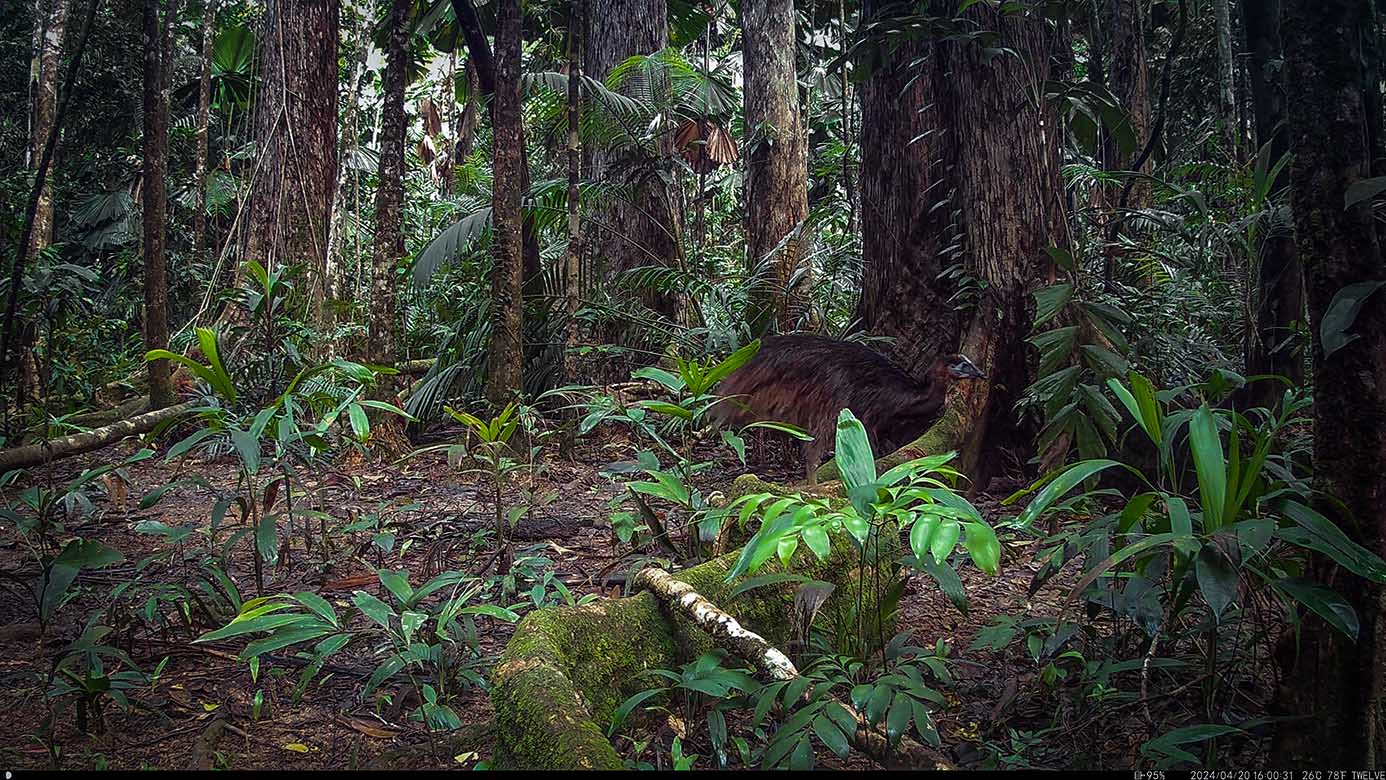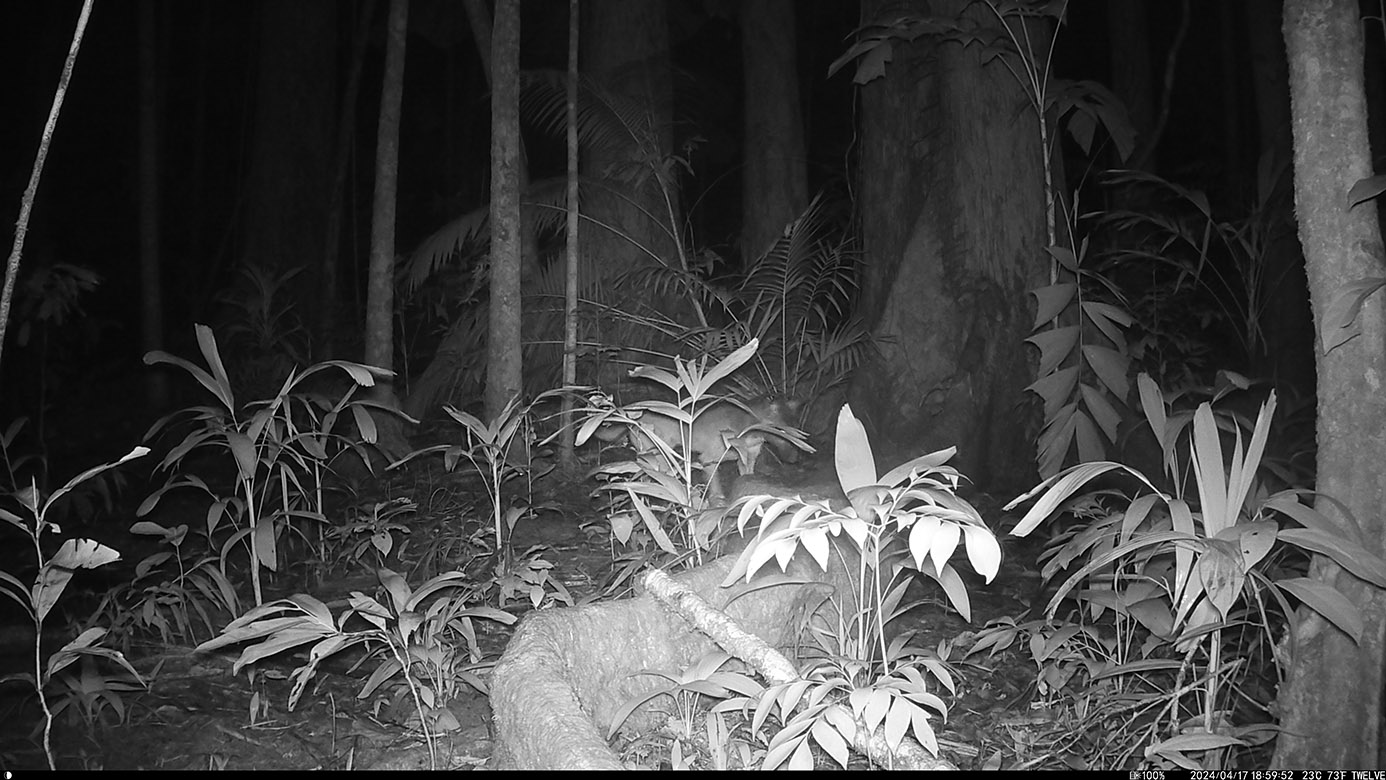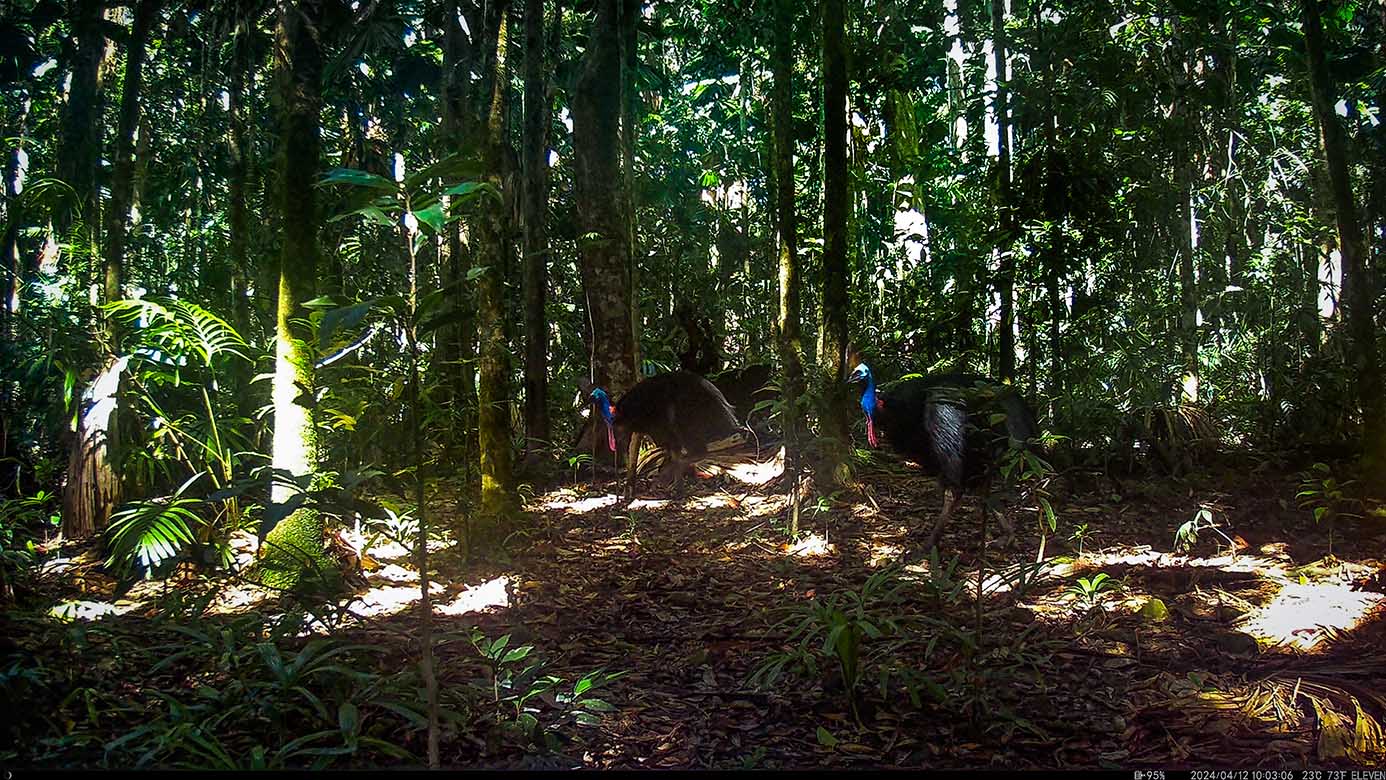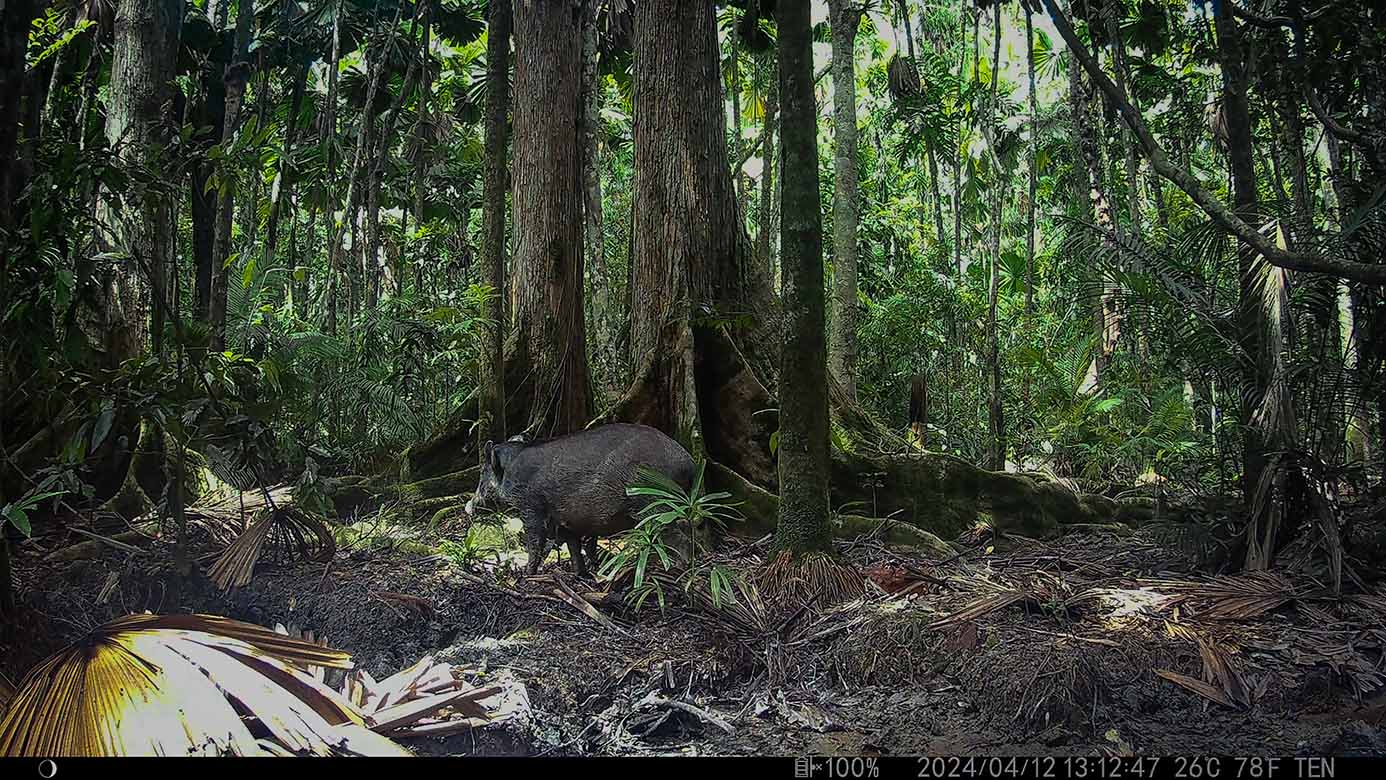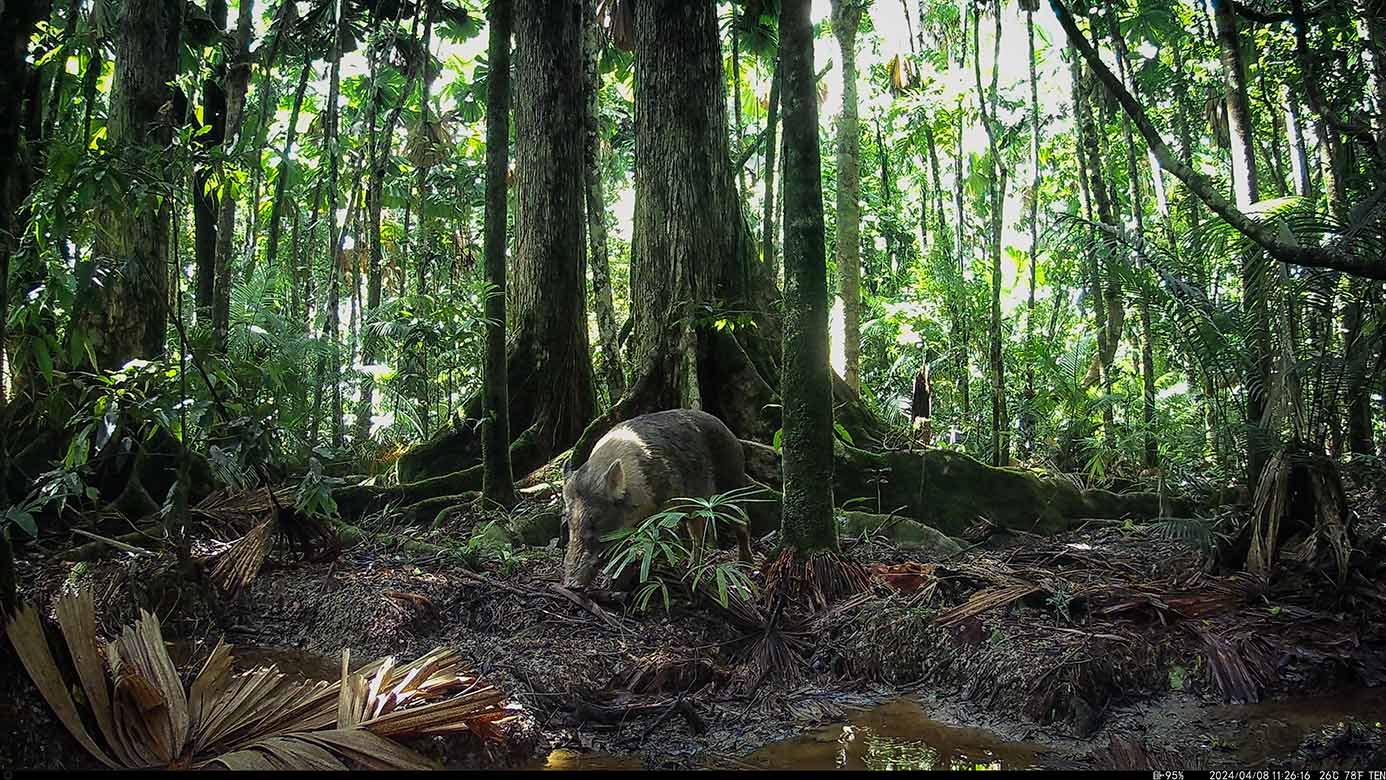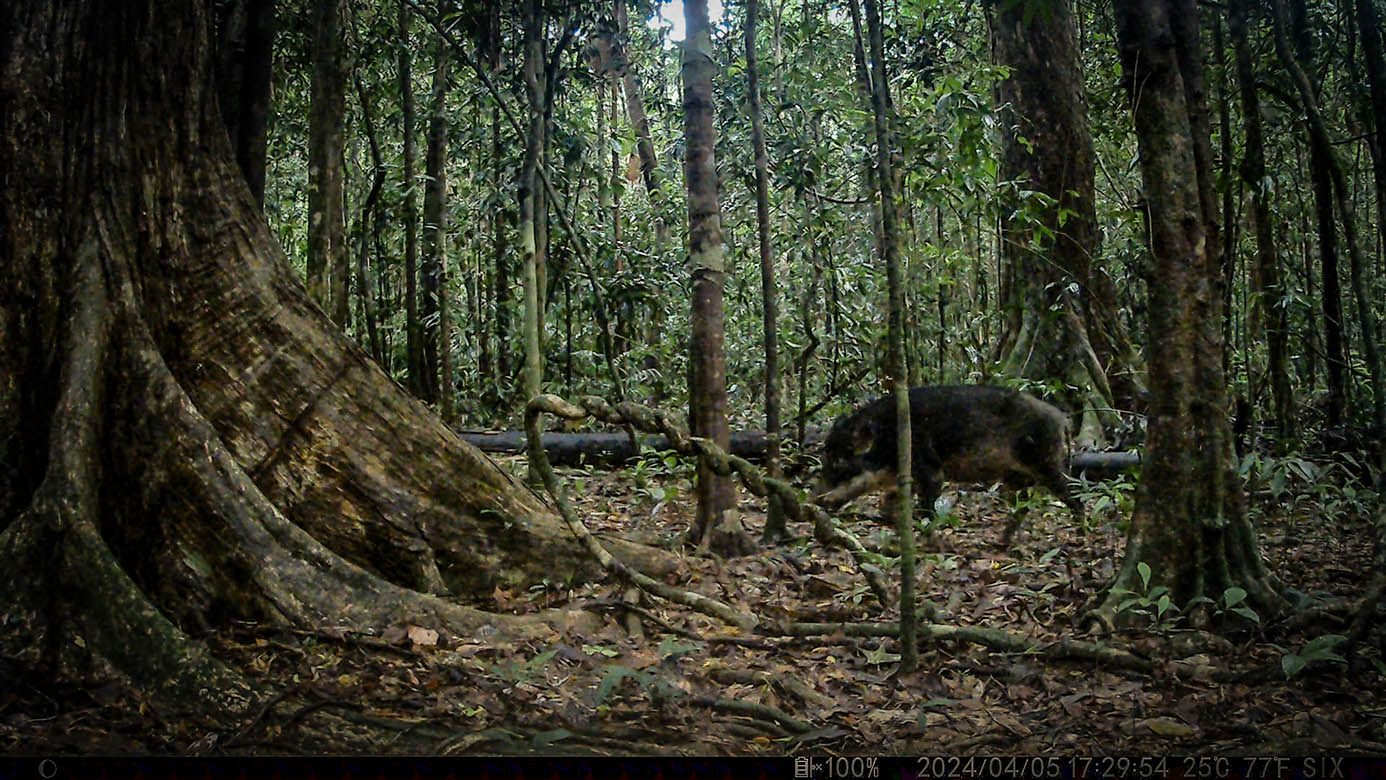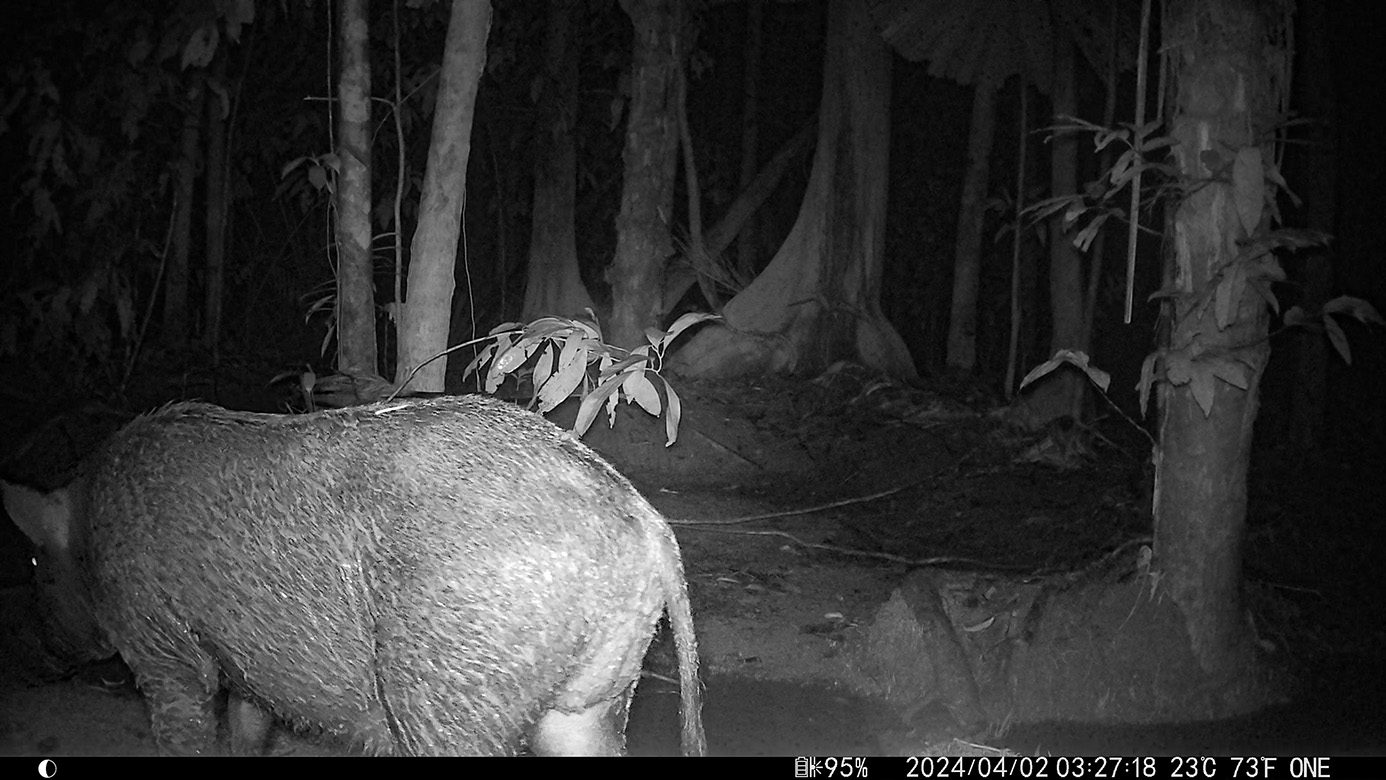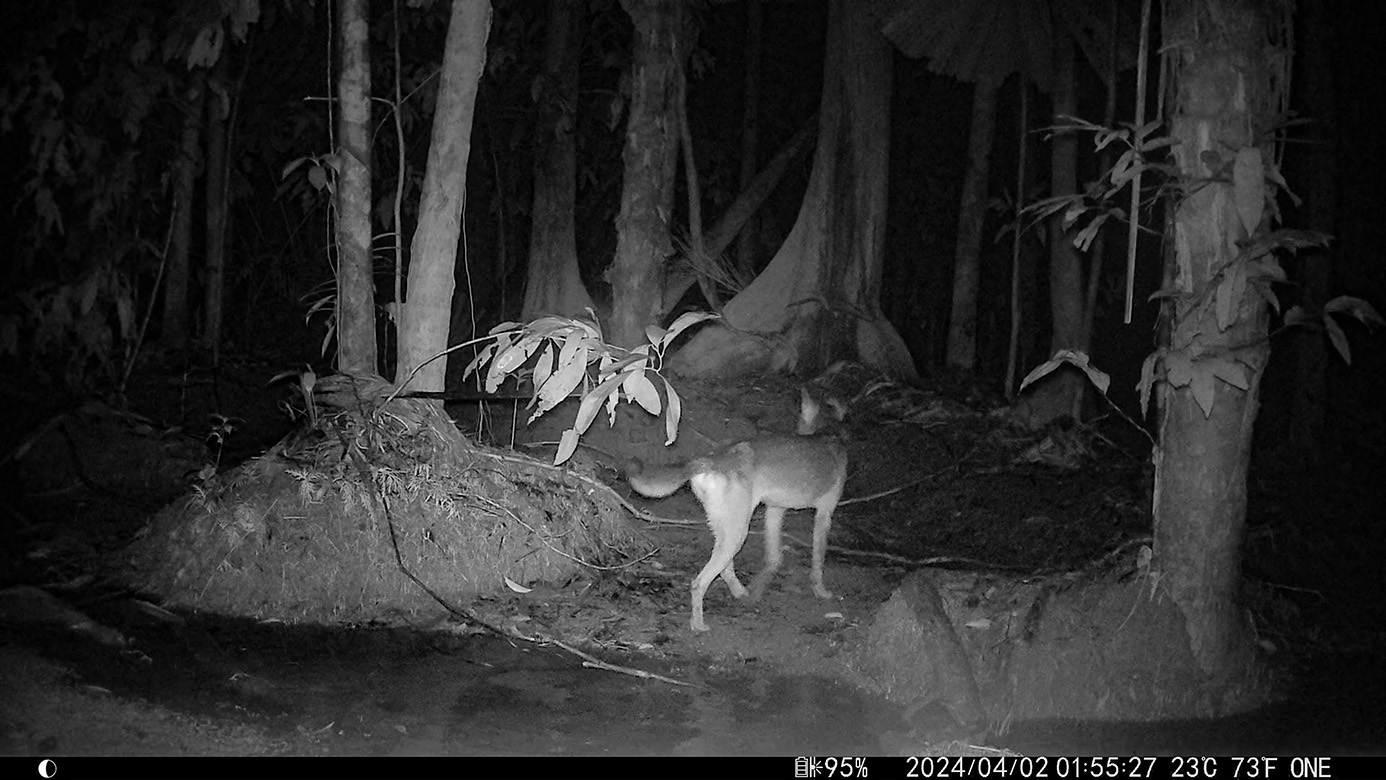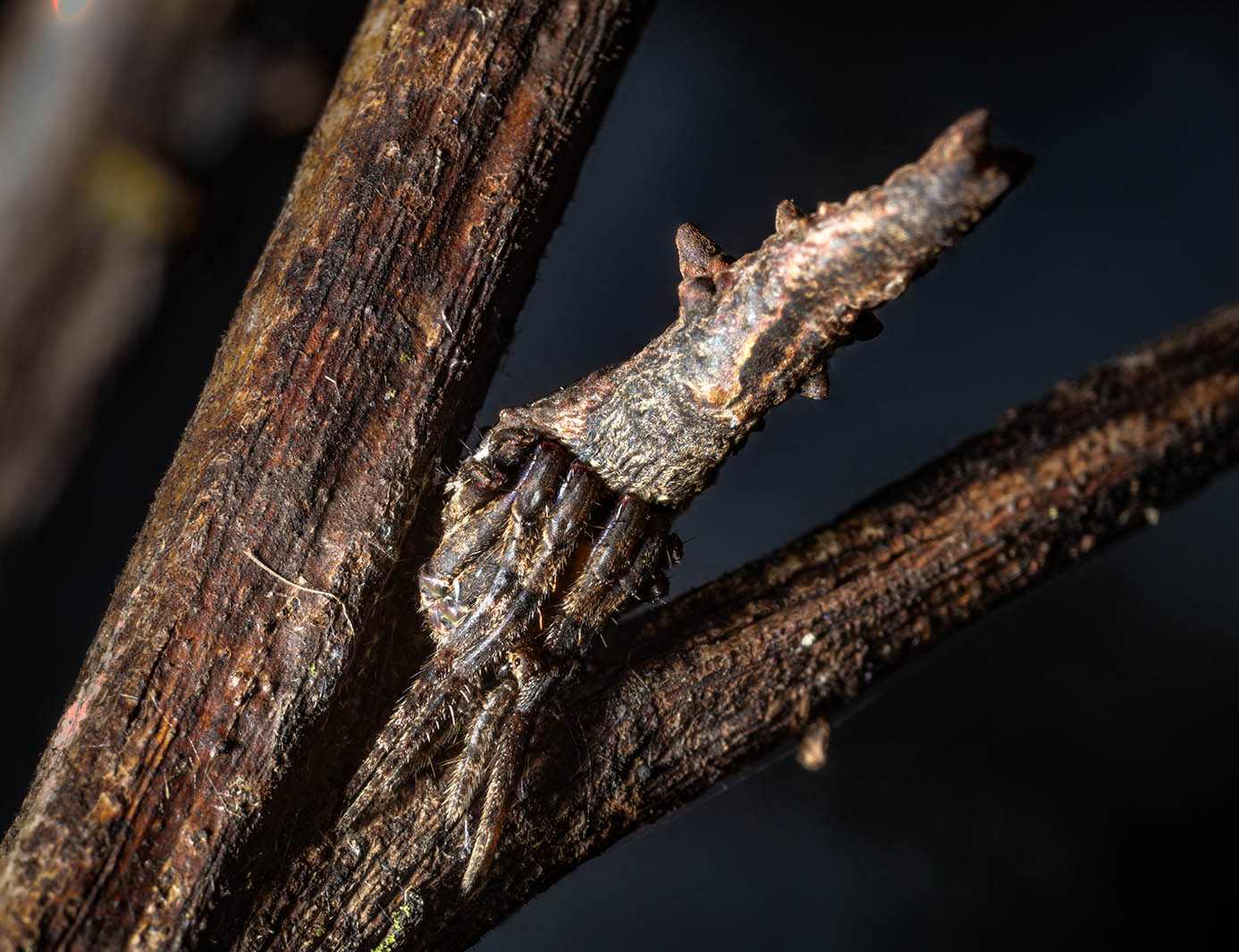Camera Traps – April 2024 accrued 59-cassowary sightings, 12-dingoes and 110-feral pigs. Against the cumulative monthly average, cassowary numbers fell by 45%, dingoes decreased by 69% and feral-pig numbers also dropped by 30%. Against April 2023, cassowaries were 65% fewer, dingo numbers dropped by 88% and feral-pigs also plummeted by 85%.
It should be noted, that relentless rainfall, post-Cyclone Jasper, has been very tough on technology and more than half of all 12-cameras had no data for the month of April, exaggerating the decline in sightings considerably.
Image highlights from April 2024
Return of the Prodigal Prudy!
Despite the poor quality of this video, the return of prodigal Prudy is an absolute delight. Since Cyclone Jasper, on 13th December 2023, this cassowary matriarch of the central section of the Daintree Rainforest, throughout which the 12-camera traps are established, has not been seen until she finally re-emerged five-months-later with this one sighting on the 15th April 2024. Deemed to have fallen with the cyclone and its ensuing floods and landslides, it is a tremendous relief to find her alive and well.
THE BEAUTY OF HIGH EVOLUTIONARY REFINEMENT
John Noble’s Poltys is a species of Poltys C.L. Koch, from a rather distinctive araneid genus that can be recognized by a combination of widely separated lateral eyes and a pear-shaped carapace, where the “stalk” of the pear is an eye tubercle. Nocturnally active, these spiders build finely meshed orb webs at night and re-ingest them around dawn. Adult males are small and do not make webs, whilst females are medium to large spiders and moths are the most frequent prey. Magnificently camouflaged during the day, these spiders hide motionless on vegetation with legs drawn tightly around the prosoma and just the median eyes, which are situated on the anterior of the eye tubercle, protruding between the legs. In this position they resemble parts of a dead twig, a gall or a broken piece of wood.
CONSERVATION IMPORTANCE OF CASSOWARIES
Plants react to damage with defensive adaptation. Consumers overcome these protective refinements with adaptations of their own. When the tussle between producers and consumers plays out longer and against a more rigorous tempo of competitiveness than any other ecosystem in the world, the forest becomes ever-increasingly toxic and a great many plants are driven beyond independent viability, into a requisite dependency upon the Southern Cassowary.
Cassowaries occupy the 20% of external sunlight that makes it into the rainforest understory. Canopy openings generated by dead-tree-falls, bring cassowaries into these shafts of illumination, asserting territorialism through the enrichment of reds and blues about their heads and necks, defecating where they spend more time, for the priority recruitment of trees that will grow to heal the overhead hole in the canopy to maintain cyclones as replenishing assets. Cassowaries also transport fruit from the competitive suppression of parent trees, onto the forest floor some 70-minutes away, with restored viability and all the requisite refinements for a secure and healthy recruitment. Thirty-seven known species of rainforest plant are utterly dependent upon the cassowary and will become extinct with the ratite’s demise, along with faunal and fungal symbionts. Indeed, the consequential cascade of extinctions should well and truly rank the Southern Cassowary as world conservation priority number-1!
In Australia, the Southern Cassowary is federally declared as an Endangered Species; its habitat is predominantly World Heritage-listed and also a declared Endangered Ecosystem Community across World Heritage boundaries. However, having greatly diminished habitat across the past 60-million years, to a veritable pinpoint of what it formerly was, Southern Cassowaries have never been closer to extinction, but under current mismanagement, this last remaining fragment of habitat currently provides inadvertent sanctuary to an estimated 30,000-feral pigs (where there should be none), pushing cassowaries ever-closer to the brink of extinction.
On top of these unfavourable conditions, a NSW-based charity – Rainforest Rescue – claims to have built the Daintree’s largest nursery that will ultimately produce 150,000 trees per year—ready for the replanting of almost 25 hectares of rainforest habitat every year! Apart from the glaring contradiction that the Daintree Rainforest is the largest nursery in the Daintree Rainforest and the Southern Cassowary is the most highly-refined and cost-effective propagator, one wonders where Rainforest Rescue is sourcing its nursery stock from? Particularly since a great many plant species cannot propagate without traversing the cassowary’s digestive system, whence it is deposited on the ground to naturally grow into a tree, with all the reinforcing refinements of an unrivalled evolutionary history. Surely, it would be counter-productive for cassowary droppings to be confiscated by visiting entrepreneurs, determined to commodify one of the Daintree Rainforest’s most valuable assets at the expense of its intrinsic value, to sell onto other people what cassowaries have already freely-given?
Daintree Rainforest Foundation Ltd has been registered by the Australian Charities and Not-for-profits Commission and successfully entered onto the Register of Environmental Organisations. Donations made to the Daintree Rainforest Fund support the Daintree Rainforest community custodianship and are eligible for a tax deduction under the Income Tax Assessment Act 1997.

